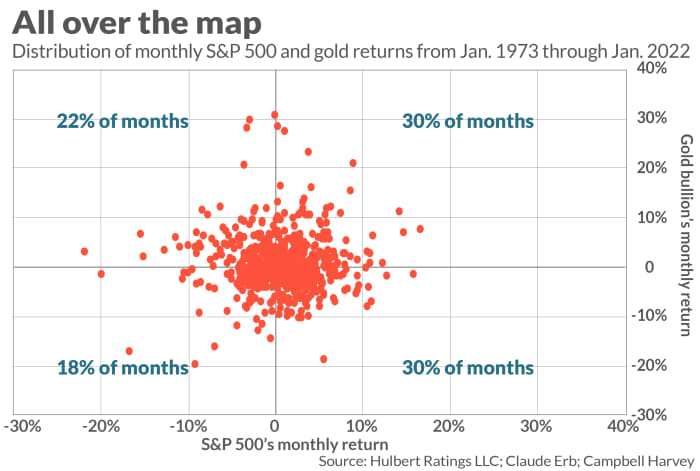This post was originally published on this site
Gold is rallying now but don’t be surprised to see prices fall if Russia invades Ukraine. That’s because the price of gold
GC00,
usually declines in the wake of geopolitical crises. Investors betting on gold because of the Ukrainian crisis should re-examine their assumptions.
Perhaps the closest historical precedent to the current crisis was Russia’s annexation of Crimea in late February 2014. A month after Russia sent soldiers into Crimea, gold bullion was 3% lower than where it stood the day before. Three months later, the price of gold was 5.8% lower than before the invasion.
That crisis constitutes just one data point, but gold’s experience is consistent with my analysis of gold’s reaction to other geopolitical crises. Consider the list that appeared in a recent MarketWatch article on how the stock market typically reacts to such crises. The table below reports the percentage of time gold declined in the wake of the dozen crises on the list that have occurred since the early 1970s, which is when gold began trading freely in the U.S.
| Over subsequent… | % of time gold at end of period was lower than where it stood when crisis erupted |
| Month | 50.0% |
| Quarter | 66.7% |
| Six Months | 45.5% |
| 12 months | 36.4% |
Given that there are only a dozen crises in this sample, the percentages shown in the table are insignificantly different from 50%. That means that our best bet is that gold’s direction in the wake of a crisis is largely a matter of a coin flip.
Gold as a stock-market hedge
The same conclusion emerges when we approach the question from an entirely different perspective. This alternate direction was proposed in a 2013 paper by Campbell Harvey, a Duke University finance professor, and Claude Erb, a a former commodities portfolio manager at TCW Group. Their idea was to focus on those months in which the S&P 500
SPX,
lost ground, on the theory that these months would include those in which geopolitical crises caused financial stress. They found that gold’s performance in those months was evenly split between gains and losses.

This is illustrated in the chart above, which plots the joint distribution of stock-market and gold monthly returns since 1973. Notice that in those months in which the S&P 500 fell, gold also fell almost as many times as it rose (18% vs. 22%). As Harvey and Erb point out, this casts serious doubt on gold’s reliability as a “safe haven asset.”
The bottom line? You may have other reasons for betting on gold. But if your rationale was hedging geopolitical tensions in Ukraine, you may want to reconsider.
Mark Hulbert is a regular contributor to MarketWatch. His Hulbert Ratings tracks investment newsletters that pay a flat fee to be audited. He can be reached at mark@hulbertratings.com
More: What a Russian invasion of Ukraine would mean for markets as Biden warns Putin of ‘severe costs’
Also read: Ukraine’s president says Wednesday ‘Will be the day’ of Russia’s attack

